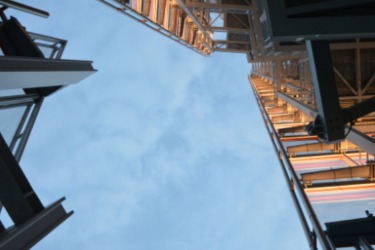It’s nice to have options. New construction can incorporate a number of structural support elements, the basic three being steel, wood or concrete. One product attempting to rival the properties of structural steel is glue laminated timber or glulam. Would your new Colorado construction project benefit most from steel or from several layers of dimensional lumber adhered together to form one strong beam? That depends on the structure, of course, and overall goals for the building.
Presently, a huge glulam marketing effort suggests that the construction industry can replace its slightly more expensive steel for engineered wood in most applications. Whether this is true remains to be seen. Since both steel and wood bring unique properties to the table, you should decide based on the three following design goals.
1. DURABILITY
With over a century of use, the long-term strength and durability of structural steel can no longer be questioned. Glulam is relatively new to the market — in use since about mid century — which is no reason to dismiss it out of hand. However, ask yourself if you would feel comfortable atop the Eiffel Tower or Empire State Building if either had been constructed with timber, were that even possible.
According to an article in Design Buildings promoting high-rise designs with structural engineered wood, the highest building with glulam bones in North America tops out at eight stories. Architects, engineers and developers of international building codes know that no matter how you join wood, and despite any other perceived benefits, it just can’t perform like steel. Even when loads will be light, wood still faces durability challenges unknown to steel, such as:
- Shrinkage from moisture loss in the semi-arid Colorado climate
- Wood-boring insects
- Water damage
- Rot
Under heavier loads, glulam columns can suffer deformations and plank delamination. Although structural glulam manufacturers conform to certain specifications for quality control, wood strength and adhesive mixes can vary. Steel, on the other hand, remains predictable and reliable. As the American Institute of Steel Construction says, “The structural steel frame will never be the limiting factor of a building’s life span. Structural steel provides the possibility of new life and use beyond its original design more seamlessly than any other material.”
2. COST
While you may enjoy a smaller initial construction outlay with a glulam-supported building, eschewing steel could evaporate savings and profits down the road. With a life cycle that can easily exceed any timber frame, the amortized expenditure for steel lowers the overall cost of ownership as the building ages.
Steel support posts and I-beams devour less of the project’s footprint and headroom than glulam while upholding the same loads. Because steel can offer longer spans with fewer support posts than glulam, you sacrifice less usable space. For industrial or commercial applications, the more numerous or larger the offices, stores or factory floor space, the more rents the building can fetch. Similarly, single and multi-family construction with more living space or number of units attract higher selling and lease prices.
3. MAINTENANCE
Maintenance needs should factor into your decision. Not only does it affect the cost of ownership for you or a buyer, regular maintenance imposes an inconvenience upon the building users. Outdoors, glulam will require regular re-finishing to maintain a waterproof exterior. Steel, either galvanized or factory primed and subsequently painted has very little maintenance needs. If exposed to the elements, steel only calls for regular inspections and coating touch-ups should scrapes or impacts damage the finish. Also consider that vertical glulam members should undergo thorough inspections every year or two to catch any cracking or delaminations in progress.
Although glulam offers certain architectural appeal for some designs, claims of its superiority to steel should be met with caution. There’s no denying the old-world beauty of wood, but there’s a reason why steel all but supplanted timber as a versatile support material. According to Structural Steel: An Industry Overview, as of 2017, steel remains the darling of the construction industry, with a 46 percent market share for commercial and multi-story residential buildings.
Please contact us at Barton Steel for more information about your new Colorado construction plans.
